#Grayanotoxins
Text
Mad Honey: A Comprehensive Overview
Unlike conventional honey, mad honey is specially made from the nectar of certain Rhododendron flowers. It has unusual qualities due to unique compounds called grayanotoxins, which set it apart from regular honey.
#madhoney #forensicscience #poisoning
Continue reading Untitled

View On WordPress
#Apis laboriosa#cases of mad honey#characteristics of mad honey#grayanotoxins#mad honey#mad honey toxicity#rhododendron
5 notes
·
View notes
Text
Language of Flowers: Rhododendron
In the language of flowers, the flower for today, October 18, is Rhododendron, which signifies danger.
Image above from Wikipedia.
Rhododendron comes from the Greek words “rhodon”, which means “rose”, and “dendro” which means tree. The bell-shaped Rhododendron flowers belie what grows beneath–leaves proven to be poisonous because of a toxin called grayanotoxin in their pollen and nectar.
Image…

View On WordPress
#birthday#dendro#grayanotoxin#herbalism#honey#Language of flowers#october#poisonous#Pompey#rhodo#rhododendron
1 note
·
View note
Text

How eating ‘mad honey’ cost Pompey the Great 1,000 soldiers. From licking toads to pouring vodka into the eyes (don’t try these at home), folks have invented some crazy ways to catch a buzz, but one way just might be the sweetest (but still stupid). It’s called “mad honey” and even though most people have probably never heard of it, this honey with hallucinogenic properties has been around since ancient times. Texas A&M University Professor of Anthropology Vaughn Bryant, one of the world’s foremost honey experts, says mad honey has a fascinating history, including its use in war. Mad honey originated in the Black Sea region of Eastern Turkey where bees pollinate fields of rhododendron flowers, some species of which have a natural neurotoxin called grayanotoxin in their nectars. The honey that results is the most expensive in the world at $166 per pound, notes Bryant, and when consumed, can cause light-headedness, feelings of euphoria and even hallucinations.
125 notes
·
View notes
Text
What species are the flowers in Fowler's fortress?
The flower with psychoactive pollen we see in episode 6 is probably entirely fictional, and not based on any specific plant. BUT Pondering over small, inconsequential details like this seems to have become my thing, so let's consider what it could be if it IS a real flower.
Based on its shape, the flower looks either like a waterlily or a lotus.
Fowler's indoor garden seems to be either directly above or otherwise near to the kitchen. Any water features such as fountains and ponds would need to be self-contained (to avoid leaking, or rotting the wooden beams between floors). Also, given how dimly lit the windowless garden is we can assume the flower blooms in the dark / nocturnally which actually narrows down which species of flower it could be considerably.
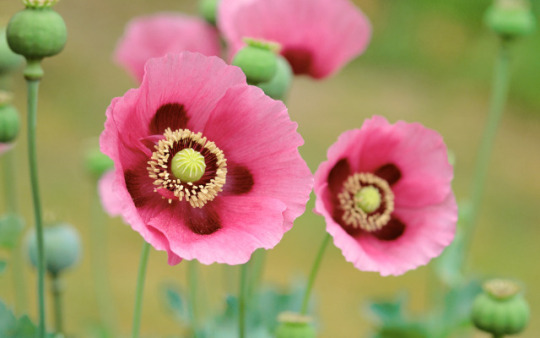
Now, originally I had assumed no waterlily or lotus is psychoactive so considered it might be a poppy instead, with the pink poppy looking the most similar to the flower in episode 6. The flowers we see are clearly growing singularly from the garden soil, rather than floating in water the way waterlilies and lotuses do. However, not only do these flower in full sun rather than nocturnally, it also turns out that there ARE psychoactive lotus flowers. Specifically Nelumbo nucifera or the blue lily flower and Nymphaea caerulea or the blue lotus, although these too bloom in the day and close up at night.
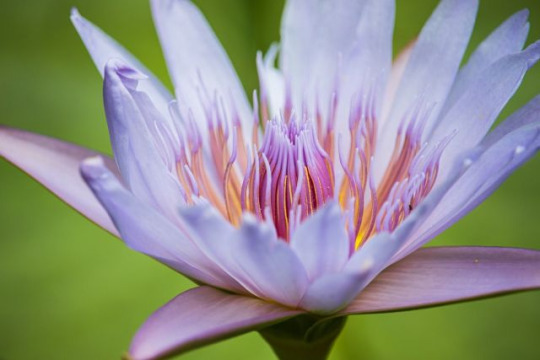
The broader taxonomy of Nymphaea nouchali / water lily has edible psychoactive roots (containing alkaloid aporphine).
It's pretty fitting for Fowler to cultivate a nocturnally blooming flower, given his crescent moon crest. Not sure if that crest is his or that of the Genghin clan, but he dons it all the same.


With all that being said, the psychoactive effects of the flower seem to stem (heh) from its pollen, not its petals as with Nelumbo nucifera. As it happens, there is a plant native to Japan which has psychoactive pollen containing "grayanotoxins" (named after Asa Gray from the 1800s. If Fowler talked about the plants it would be very anachronistic for him to use this term, so he probably wouldn't). These are a type of neurotoxin produced by the family Ericaceae (including the rhodedendron flower - not especially similar to Fowler's flower as they tend to grow in clusters with relatively smaller flower heads), with the different isoforms (structure variations) of the grayanotoxins each flower species produces varying the plant's toxicity. Whatever grayanotoxins are in Fowler's flowers' pollen act pretty quickly so are probably on the more potent end (so probably grayanotoxin III?)

"Mad honey" can be made from pollen contaminated with grayanotoxins, but the pollen itself is still psychoactive.
Overall, no specific existing flower species seems to perfectly fit Fowler's flowers. Lotus look the closest but don't grow in the conditions shown in the show and have psychoactive roots rather than the psychoactive pollen of rhodedendron flowers. If any BES fans are botanists or specialise in plants / environmental science / botany / related sciences, I'd love to hear what you know and think would be more appropriate candidates!
#blue eye samurai#abijah fowler#abijah blue eye samurai#Post didn't show up on the tags for some reason so fiddled around with it until it did#Another tangent about details that don't matter but brainrot got me good#Tempted to plant some blue lotuses and rhodedendrons now#botany#plants
36 notes
·
View notes
Text
A Completely Normal Post About Plants.
Specifically the poison kind. A continuation of this conversation with @crowsandturtlesandbatsohmy and @icequeenabby.
I will go over some of my favorite poisonous plants, and a plant that @nyaboshi brought up because it's really cool. I will share a picture of each plant, a fun fact about it, if it is used in medicine or if it has another purpose, the type of poison/toxin it contains, and what that does to the human body.
Disclaimer: I am not an expert. Just someone who enjoys hyperfixating on many different subjects. Enjoy my brain rot.
Anyways the plants:
CW: Mentions of death, execution, and poison (obviously lol)
IMPORTANT!!!! Just in case I forget to mention this on any of these plants, every part of all these plants is toxic.
Another note: Whenever I refer to gastrointestinal issues/diseases, I am usually referring to nausea, vomiting, diarrhea, stomach/abdominal pain, etc.
Foxglove
(Digitalis)

My favorite poisonous flower.
Did you know that this flower is mistaken for Comfrey, another plant who's leaves are used to make tea? This mistake has resulted in illness and several deaths.
Truly akin to this scene (iykyk):
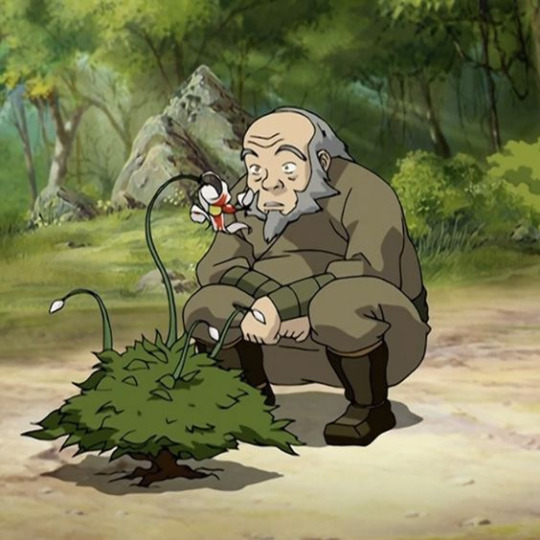
Uses: This is used in certain medicines to slow down heart rates, due to high blood pressure, and in medicines for heart failures. It is possible to be poisoned from overdosing on this medicine.
Type of poison: Foxglove has a toxin known as digitalis/digoxin. Side effects of this poison include blurred vision/yellow or green vision [xanthopsia] (and seeing a halo like shape around lights), fatigue, gastrointestinal effects, weakness, bradycardia [a heart rate under 60 bpm], lower platelet counts (thrombocytopenia), arrhythmias [irregular heart beats], and the very rare case of cardiorespiratory failure. These symptoms can occur through consumption of the plant, and sometimes through over doses on the medicine. It can cause irritations to the skin, like rashes, if touched, and can cause terrible reactions from its pollen in certain individuals.
Oleander
(Nerium Oleander)


Many oleanders have a sweet, vanilla-like smell, however it is not recommended to smell them up close. These plants have been well documented in history, from Greek mythology to Vincent Van Gogh's painting titled "Oleanders." Despite it's deadly nature, it is quite popular among gardeners.
Uses: This plant is traditionally used to treat heart problems, asthma, and even cancer, but there is not enough evidence to support this actually having a positive effect. However there is more evidence of the leaves of the oleander being used as an effective anti-inflammatory and antioxidant under the right dosage.
Type of poison: The main type of poison in this plant is called toxic cardiac glycosides. But it also contains the poisons oleandrin, oleondroside, and digitoxigenin. These chemicals are found in all parts of the plant and affects the heart the most. The side affects if consumed include gastrointestinal effects, xanthopsia (yellow vision), eye irritation and burning sensation, effects to the nervous system such as tremors, seizures, coma, and cardiac effects including an increased heart rate that quickly slows to the point of death in some cases. If touched, it causes skin irritations and rashes, and can cause respiratory issues of the wood and leaves are burned.
Japanese Pieris
(Pieris Japonica)


This is a plant that @nyaboshi shared with me. This plant is native to several countries in Asia, including Japan, China, and Taiwan. It is a symbol of powerful beginnings and new opportunities.
Uses: The main use of this plant is for a honey made from this plant called "Mad Honey," and it is used as a traditional medicine and for intoxication (which can lead to overdose and poison).
Type of poison: These plants contain Grayanotoxins. These affect the brain, nervous system, and heart. If consumed, this plant causes blurred vison, slower heart rates and lower blood pressure, gastrointestinal effects, weakness, fainting, cardiac failures, coma, and neurological side effects.
Deadly Nightshade
(Atropa Belladonna)


Quite the popular choice for poisoning. There are many many references to this plant in popular books, shows, and movies. It is also famous for being tied to witchcraft. Belladonna, as it is commonly known, is one of many in the Nightshade plant family. Some well known edible Nightshades include tomatoes, potatoes, eggplants, and tomatillos. But Belladonna isn't the only dangerous plant in the Nightshade family, she has other deadly sisters.
Uses: This was used in cosmetics once upon a time. Please do not use it as such please. Surprisingly, there are many uses for Belladonna! Under the right doses, correct mixing of chemicals, and correct consumption/other way of taking this plant can help in reducing symptoms asthma, motion sickness, hemorrhoids, whooping cough, irritable bowel syndrome, and a few other ailments.
Type of poison: This plant contains alkaloids, such as hyocyamine, scopolamine, and atropine. Belladonna is known as one of the most toxic plants that we know of. Consuming this plant, including medicated Belladonna, can cause cardiovascular diseases (and other heart problems such as tachycardia [increased heart rate]), gastrointestinal disorders, complications during pregnancy, psychiatric/neurological disorders, rash, headache, staggering/loss of balance, delirium, dilated pupils, blurred vison, sensitivity to light, severely dry throat and mouth, hallucinations, confusion, constipations, and convulsions.
Touching these plants can cause severe dermatitis and may cause its toxins to seep through the skin.
Giant Hogweed
(Heracleum mantegazzianum)
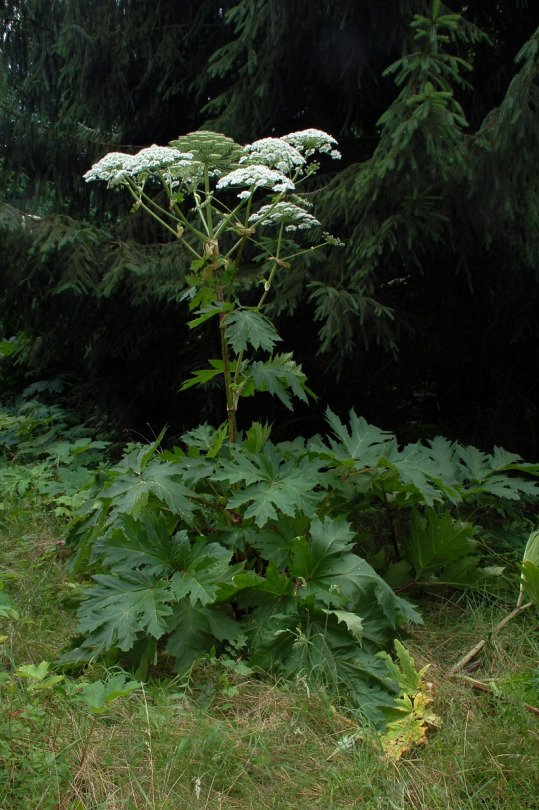
Considered to be a very invasive species. It is widespread across east to west Europe, Canada, and in the united states. Because of it's dangerous nature, it is deemed by U.S. officials to be a noxious plant, so that the spread of this plant can be limited.
Uses: Not really. Its cousin the common hogweed was used in some medicines, but I would not recommend going near these.
Type of poison: The sap of this plant contains furanocoumarins, which combined with sunlight is severely phototoxic. When any part of the plant is touched, but especially the sap, this causes severe phytophotodermatitis, a terrible and serious skin inflammation, that includes severe blistering (and I mean SEVERE! If you have a strong stomach look it up examples of reactions you dare), a deep red rash, and even photosensitivity. And if you accidentally touch your eyes after exposure, it can harm your vision and even cause blindness.
I haven't seen information for when it's consumed, which is a good thing. It would probably cause intense internal damage.
Please just avoid this plant. For some reason I do not like this plant one bit. Whenever I see this plant I go : ಠ╭╮ಠ
Poison Hemlock
(Conium Maculatum)

You have probably heard of this plant or one of its siblings. This plant was used to execute prisoners in ancient Greece, including the famous philosopher Socrates. Fun plant huh? Also invasive.
Uses: Has been used as a sedative, antispasmodic treatment for symptoms of irritable bowel syndrome, and for some respiratory diseases, all in very small doses. However, there is not enough evidence to really tell if these are positively effective.
Type of poison: Similar to Belladonna, this plant contains alkaloids, including C. maculatum, conium, and coniine. If ingested, it attacks the nervous system, and can cause fatal neuromuscular dysfunction as it will stop the movement of muscles in important organs including respiratory muscles, muscular paralysis, unconsciousness, coma, urination, depression, trembling, and weak or slow heartrate.
It is generally safe to touch poison hemlock, but it is better to be careful and safe.
Bittersweet Nightshade
(Solanum Dulcamara)

Remember I mentioned Belladonna plants have other deadly siblings? Meet her bittersweet sister. In the Middle Ages this plant was said to ward off witchcraft (because of course it was). An interesting fact about this plant is that while it is toxic to humans, there are several bird species that love feasting on the berries.
Uses: This is used for skin conditions such as acne, eczema, itchy skin, broken skin, and a few others. It is also used for inflammation and easing arthritis, along with easing respiratory issues and illnesses like bronchitis, asthma, and pneumonia.
Type of poison: This plant contains solanine and a glycoside called dulcamarine. If consumed, and if over consumed via medical prescription, this plant can cause several gastrointestinal problems, confusion, mydriasis (dilation of the pupil), paralysis, delirium, numbness, shortness of breath, low pulse/slowed heartrate, convulsion, and weakness. It is unwise to take this during pregnancy.
This plant like is sister plant, should not be touched. Its toxins can be absorbed through the skin. So no touchy!
Western Monkshood/Wolfsbane
(Aconitum Columbianum/Aconitum Napellus)

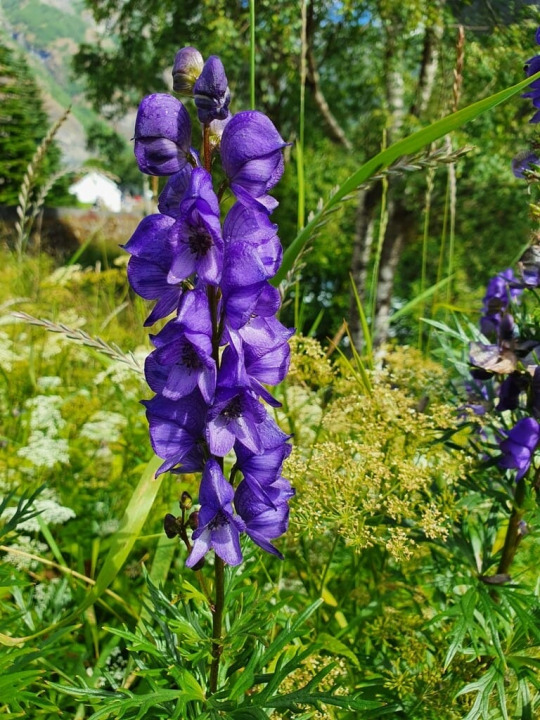
This is plant is surrounded by myth and a long history. In folk tales, it was considered to kill werewolves and normal wolves, hence one of its names. In ancient times it was occasionally used as an herbal medicine, however, it has more of a reputation as a poison for executions and assassinations.
Uses: Once upon a time, this plant was used to reduce fevers, as an anti-inflammatory, sedative, and to relieve other ailments. However, this plant is considered to be one of the most poisonous plants in Europe, so the thought of someone using this today, is very unlikely.
Type of poison: This plant contains aconitine and mesaconitine, which is a dangerous neurotoxin and cardiotoxin. Side effects of consumption include gastrointestinal issues, cardiovascular issues (weak/irregular heartbeat, slowing and stopping of the heart), difficulty breathing, asphyxiation, neurological issues, paralysis, pain, convulsions, multiple organ failure (especially of the liver and kidneys), numbness (especially of the mouth and tongue), and paraesthesia (feeling sensations in the skin for no apparent reason, like feeling cold, tingly, or clammy).
Do not touch this plant. The toxins can be absorbed through the skin, and can cause many of the same effects if consumed, and can cause numbness wherever you touched the plant.
Lily of the Valley
(Convallaria Majalis)

Such a pretty pretty flower to finish of this list! This flower has been the national flower of Finland since 1967 (my gran's home country)! It is also the national flower of Yugoslavia. This plant is very popular, and has been used in many wedding bouquets, has been in several myths, the subject of art, poetry, music, and even shows (like "Breaking Bad").
Uses: Besides it being used for its sweet fragrance, it is supposedly effective heart problems, such as irregular heartbeat and heart failure, urinary tract infections, and kidney/bladder stones (HOWEVER, THESE ARE CLAIMS OF FOLK MEDICINE, NOT FACT).
Type of poison: This plant contains convallatoxin, which is similar to digitalis. If ingested it can cause heart problems such as irregular heartbeat/slow heartbeat and collapse, gastrointestinal issues, loss of appetite, excessive urination, confusion, drowsiness, weakness, depression, headache, disorientation, and lethargy.
This plant may cause skin irritation and possibly a rash/hives if handled for too long.
________________________________
There are many other plants I have done research on, including mushrooms, but I'll stop here for now (for my sanity). I hope y'all enjoyed reading this!!!
*Bows*
Have a good day or night!!
I shall now pass out.
#exhausted's half awake jumbles#hyperfixation time babyyyyyyyyy!!!!!!!!!!!#cw mentions of death#tw mentions of death#cw poison#tw poison#poisonous plants#poisonous flowers#fun facts#medical terminology#cw mentions of execution#tw mentions of execution#I'm not going to be caught by the content/trigger warning police today!
30 notes
·
View notes
Text
Kusuriya no Hitorigoto Part 1A: OP1 Hana Ni Natte
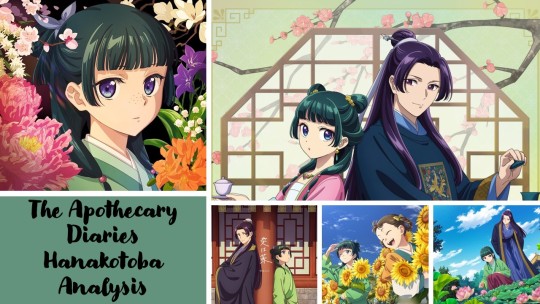
┏ · ──────── ·𖥸· ──────── · ┓

The first eight flowers in the anime's first opening "Hana Ni Natte" correspond to brief, individual story arcs in the first cour of season 1...
-> 1.1) Rhododendron
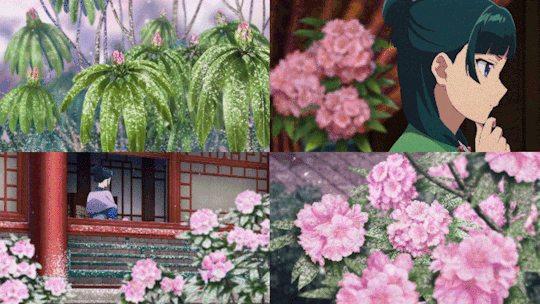
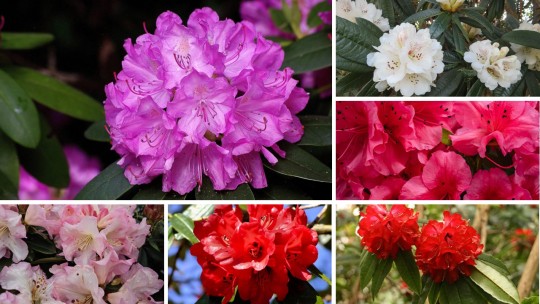
The 1st flower depicted in the opening is the Rhododendron (Rhododendron sp.)—which is also featured during episodes 1 and 2.
In Japan, this flower is called shakunage (石楠花). It symbolises majesty, danger and caution in hanakotoba. The Rhododendron’s symbolism of “majesty” is believed to be derived from its beautiful, bountiful flowers while its symbolism of danger and caution stems from the poison in its leaves. Rhododendron plants contain toxic compounds known as grayanotoxins, which, if consumed, can be dangerous to humans and cats.
The symbolism of the Rhododendron in other countries is similar to that in Japan. In Western floriography, it represents danger, caution, and suspicion. In contrast to this, the flower also represents beauty, fragility, and grace due to its intricate shape. Pink rhododendrons in particular represent self-love and compassion.
-> 1.2) Cotton Rose
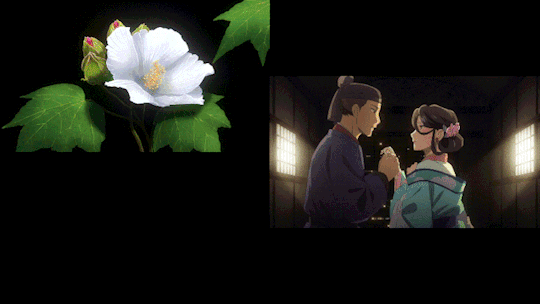

The 2nd flower featured in the first opening is the Cotton Rose (Hibiscus mutabilis)—also called the cotton rosemallow or confederate rose. Cotton roses were featured in the third episode of the anime and are canonically associated with Princess Fuyō who shares her name with the flower. Notably, in the opening the double-flowered variant of the Cotton rose was used rather than the standard version used in the anime.
In Japan, cotton roses are called fuyō (芙蓉). In hanakotoba, it symbolises delicate beauty and gentle love—likely derived from its flowers which evoke a delicate, soft feeling. This flower exhibits a phenomenon known as floral colour change, in which the blossoms are white in the morning, pink around midday, and red by nightfall. Cotton roses can be toxic to humans, potentially causing skin irritation and burns if incorrectly handled.
Cotton roses are most commonly symbolic of eternal love, devotion, and affection in Western floriography. It also represents sacrifice and resilience—and is historically tied with the American Civil War. The flower's capability to change colour from white to red has made it a symbol of the transformation and adaptability that individuals and communities endure during times of conflict and transition.
-> 1.4) Violet
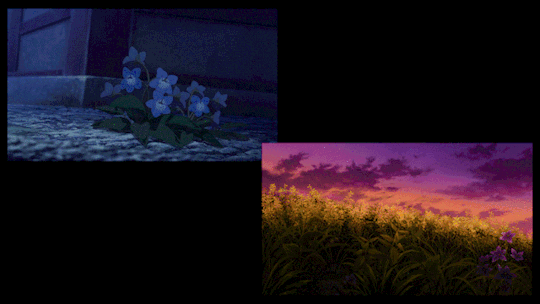

The violet (Viola mandshurica) is the 4th flower depicted in the first opening; they also appear briefly in Episode 5. While generally not harmful to humans, some violets contain substances that can harm cats if ingested.
In Japan, they are called sumire (菫). In hanakotoba, violets symbolise honesty, humility, sincerity, and small happiness. Purple violets in particular represent chastity and love. Their representation of humility and honesty is probably derived from their profound blossoms, which thrive discreetly by the roadside or in the grass.
In Western floriography, violets symbolise modesty, faithfulness, intuition, spiritual wisdom, harmony and balance. Purple violets symbolise daydreaming and “you occupy my thoughts”—while blue violets symbolise honesty, love, trust, commitment and devotion.
-> 1.5) Montauk daisy


The Montauk daisy (Nipponanthemum nipponicum) is the 5th flower depicted in the first opening, and additionally, they also appear briefly in episode 6. Some daisy varieties can be mildly toxic to humans—causing irritation if consumed—but poisonous to cats.
In Japan, they are called Nippon giku (日本菊) and represent faith, peace, hope, chastity, beauty and facing hardship in hanakotoba. White daisies in particular symbolise innocence. Its symbolism of beauty is derived from its Latin name while its symbolism of hope is derived from the property of its flowers to open when light shines on them.
In Western floriography, daisies symbolise chastity, beauty, rebirth, new beginnings and hope. This is because they are usually the first flowers to bloom in the spring. White daisies represent purity and innocence; whilst pink daisies represent gentle admiration, affection or adoration. Daisies also represent loyalty, love, simplicity, humility and the ability to keep a secret.
-> 1.6) Toad Lily
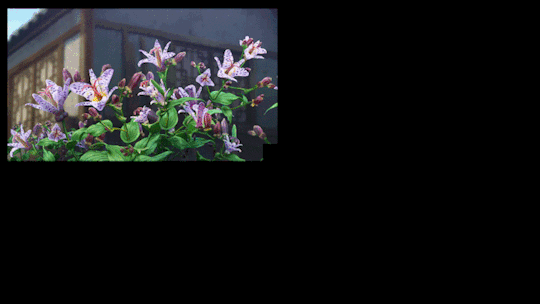

The 6th flower depicted in the first opening is the Toad lily (TricyrtIis hirta), which also appears in episode 8 of the anime. Although toad lilies are not regarded as being highly toxic, they are poisonous to cats.
In Japan, toad lilies are called Hototogisu (ホトトギス)—which coincides with the Japanese name with the lesser cuckoo bird. This is because the markings on its petals are similar to those on the bird's chest. consequently, the "Little Cuckoo" lullaby sung by the courtesan in episode 8 and Fengxian in episode 23 shares the same name as the flower. In hanakotoba, toad lilies symbolise loyalty, friendship, hidden thoughts and “forever yours”.
In Western floriography, toad lilies symbolise elegance, beauty, and fertility. In Buddhism, they symbolise wisdom, strength and compassion.
-> 1.7) Nandina


The 7th flower depicted in the first opening is Nandina (Nandina domestica)—often called heavenly bamboo or sacred bamboo. This plant is also featured in episode 9 of the anime but is depicted as a fruit rather than a flower.
In Japan, the Nandina is called Nanten (南天) and symbolises “good family” and “my love only grows” in hanakotoba. Nandina blooms with small, white flowers in early summer)—before developing little fruits that gradually redden as winter approaches giving rise to its symbolic representation of "My love only deepens." Additionally, Nandina's symbolism of a "good family" stems from its abundance of fruits, which are interpreted as a symbol of prosperity for offspring. On New Year's Day, the nandina is also considered an auspicious tree to ward off catastrophes.
In Western floriography, the nandina represents good luck, fortune, and prosperity. This is due to the Nandina being considered a lucky charm in Japan, which has recently led to it becoming a popular housewarming gift. Despite its positive meaning, Nandina is highly harmful to birds and mammals. However, it is widely regarded as non-toxic to humans.
-> 1.8) Azalea
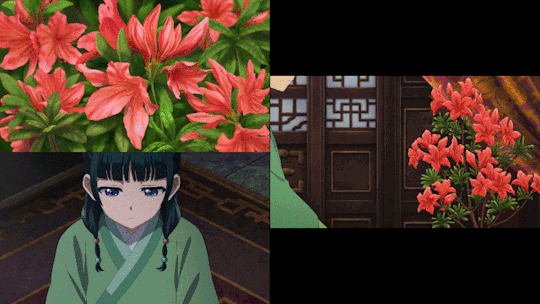
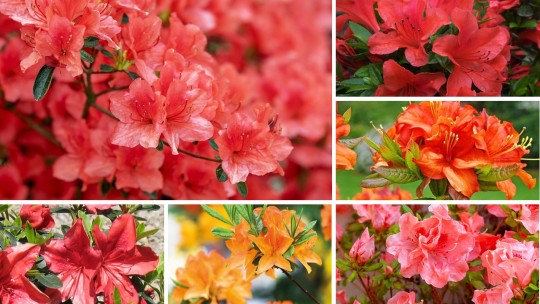
The 8th flower depicted in the first opening is an orange azalea (Rhododendron japonicum). Additionally, red-pink azaleas appear during episode 11. Aside from its beauty, the azalea is known for being extremely toxic—it contains andromedotoxins in its leaves and nectar, including honey made from the nectar. Given that its nectar is equally hazardous, Japanese beekeepers avoid gathering honey during its flowering season in areas where it grows naturally.
In Japan, these flowers are called renge tsutsuji (蓮華躑躅) and represent patience and modesty in hanakotoba. Orange azaleas symbolise passion and constancy—while red azaleas represent temperance and "burning thoughts".
In Western floriography, azaleas represent temperance, prudence, caution, love, passion, and romance. Since azaleas symbolise temperance, which refers to self-restraint—particularly when confronted with temptation—they are considered a representation of moderation or the balance of different elements in one's life. Orange azaleas specifically symbolise vitality, excitement, encouragement, adventure and discovery. While red azaleas represent love, beauty, passion, and desire, as well as a woman's tenacity and defiance. Additionally, azaleas can represent fragile love as their blossoms easily come off from their stem upon the slightest touch. Consequently, the flower is used to signify a fragile love that can still persevere into a lasting one. Due to the Azalea's toxicity, in certain cultures, giving someone a bouquet of azaleas in a black vase is taken as a death threat.
┗ · ──────── ·𖥸· ──────── · ┛
Part 1A│ Part 1B │Part 2
╰➤ Other anime & donghua hanakotoba posts
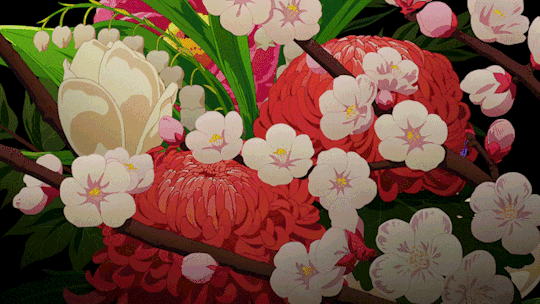
[A/N: Please check out part 1B and part 2 as well! Since I've only watched the anime but haven't read the manga or light novels and thus cannot comment on how everything ties into the overarching storyline or character development—I didn't go into too much detail here... Also, since there are so many flowers featured, this post would grow way too long if I did lmao.
If anyone has any ideas on what anime/anime theme song I should cover next in this series please lmk✿ Also, if you liked this post, check out my other hanakotoba analysis posts...]
#kusuriya no hitorigoto#apothecary diaries#the apothecary diaries#jinshi x maomao#maomao#jinshi apothecary diaries#maomao apothecary diaries#hana ni natte#hanakotoba#hanakotoba analysis#flower symbolism#anime flower symbolism#anime hanakotoba#anime opening symbolism#anime symbolism#anime#manga#anime analysis#floriography#jinmao#apothecary diaries anime#apothecary's soliloquy#薬屋のひとりごと#maomao x jinshi
10 notes
·
View notes
Note
Saw your adorable Barbie background for your blog, and I had to share some cursed brain rot I had related to Barbie!
Rothbart from Barbie: Swan Lake, is a legitimate good father. Sure he had his moment where he left Odile as a pig, but the fact that he was about to try and end Odette and Daniel, but came to Odile when he heard her scream when she was being sprayed by skunks is still such a win for him!
So since your requests are open…yan hcs for Rothbart? When he younger of course…cause I was always so bummed his wife was never in the picture. I know this is so cursed…

i’ve actually never watched barbie swan lake so i made the stupid decision of skipping to the parts the bird man was in. idk why i did that. i was so confused. bro really saw barbie in a forest, arched his back, threw some magical beam at her through a ring, turned her into a swan, didn't elaborate and flew away.
we're not going to talk about how i thought his daughter was his wife at first. i was about to come for you if you were simping over a married man in low qual 00s barbie 😭 him as a human in that ball scene tho- i listen to whatever doja says
anyway, here it is. love anything cursed i eat it up.
✮ft: yan!rothbart / yan!prince

yan!prince rothbart who almost immediately took a dislike to you, his personal maid, personal servant, his own little retainer, and any other words that can fit that category. he hated the way you looked at him, so naive, as if you truly believed that he could rule over this forest, as if you truly believed he would be picked over his cousin. it was truly pathetic.
yan!prince rothbart who would study day in and out until the sun rose and fell into those trees, all the while you were there for every minute of it. need a new book or for you to return one that’s all the way in the back of the library just so your annoying presence is gone? of course, you’ll do it! it’s what the future king wants, isn't it?
yan!prince rothbart who hears the kitchen staff talking rather rudely about him after you take too long to fetch him some bread to eat. they weren't wrong speaking about how he just wants to rule the forest, but they would do the same. he wanted to wait until it died down until you finally spoke up to cut them off.
“prince rothbart isn't anything like that! he’s kind and studies more than any of you would! he would be a better ruler than any of you!”
yan!prince rothbart who maybe slowly starts to relish in your presence. you were one of, if not the first, to be on his side and want him to become king. after everything he’s put you through, you still want him as king. it was so dimwitted and simple. you were so dimwitted and simple. then why did you always make him seem so much lighter?
yan!prince rothbart who is still agitated how you followed him around like a lost duck everywhere he went. how you didn't understand anything about the land or policies, laws, politics, but it almost became therapeutic to him; his own little escape.
yan!prince rothbart who found himself slipping from his studies to escape with you. running away to the forest for a small picnic by the river, your laugh so elegant as animals would run to you and away from you. your teasing words as he pretended not to care if a hedgehog almost chopped off his finger echoed in his ears like a symphony.
yan!prince rothbart who wanted to spend more and more time with you. that is your job, after all. you should be more than willing to devote more time to him, whether it be sneaking off to help him find some berries or leaves or just a way to escape classes or studies.
yan!prince rothbart who decides that he should give something back to you after all these years of being by his side. specially brewed tea mixed with the finest wild honey and a scrumptious grayanotoxin. you would never need to be knowledgeable about the mad honey disease, as the common people called it. you’re just sick is all! the doctors can check, even if they find nothing.
yan!prince rothbart who has moved some of his studies to your cramped room. you don't want him in here? you don't want him to catch your little fever? he should be studying? oh, but he is studying. you're just here to keep him in high spirits! after all, it is so funny when you ask him what something means. just how could you not know what hunting laws indicate as a servant?
yandere!prince rothbart who is always the only one to serve you your favorite honey tea. it’s just so yummy, making you feel better! it’s not as if he’s the one holding you hostage in this bed with it! no, never!
yan!prince rothbart who once he is of age finally hears of who will be king or queen, finally snapping at you. everything imaginable is thrown at your cowering body. a teacup holding scalding tea goes first, shattering behind you, tea imprinting on the wall as a loud crash is heard.
“this is all your fault! if i had studied more and not spent so much time with you! you pathetic dumb little pauper! i should be king!”
yan!prince rothbart who hurried over to your twin-size bed, sitting down next to you, dipping the bed, cradling your weak frame in his arms. Whispers of sweet nothings resonated in your ear as he stroked your arm up and down. You’re always there; why should he not repay you by ruling over him? If you want to or not, of course, isn't up to you. If it ever was, it would never even be a question but a fact; that answer being no.
“my dear [y/n], this land no longer needs us. for now, be with me. stay by my side until i- no, we shall rule this forest.”


#。˚꩜.no gunsHCs#what am i doing#what is my life#x reader#barbie x reader#barbie#rothbart#rothbart x reader#barbie swan lake#prince#prince x reader#yan x reader#yandere x reader#yandere#yan prince x reader#yandere prince x reader
35 notes
·
View notes
Text
Feline Friends and Green Companions: Navigating the Safe Greens for Your Cat
Cats and plants share our living spaces, bringing joy, comfort, and a touch of nature’s beauty into our homes. However, the coexistence of our feline friends with our green companions can sometimes pose hidden dangers. A number of common houseplants are toxic to cats, potentially leading to a range of health issues. On the flip side, many plants are perfectly safe and can even contribute to a stimulating environment for your pet. In this article, we’ll delve into which plants to keep and which to avoid to ensure the safety and happiness of your furry family member. We’ll also explore the signs of a sick cat, so you can act swiftly should your pet ingest something harmful.
Plants That Pose a Danger

Lilies (Lilium spp. and Hemerocallis spp.): Extremely toxic to cats. Even small ingestions can cause severe kidney damage.
Sago Palm (Cycas revoluta): Contains cycasin, which can cause vomiting, liver failure, and potentially death.
Diffenbachia: Can cause oral irritation, intense burning and irritation of the mouth, lips, and tongue, difficulty swallowing, and vomiting.
Azaleas and Rhododendrons (Rhododendron spp.): Contain grayanotoxins that can lead to vomiting, diarrhea, drooling, and potential central nervous system damage.
Tulips and Hyacinths (Tulipa and Hyacinthus): The bulbs of these plants contain toxins that can cause intense stomach upset, drooling, loss of appetite, depression of the central nervous system, convulsions, and cardiac abnormalities.
Safe Greens for Your Cat

Spider Plant (Chlorophytum comosum): Known for its air-purifying qualities, it’s safe for cats and often attracts them with its dangling spiderettes.
Boston Fern (Nephrolepis exaltata): A non-toxic plant that adds lush greenery and is safe for cats to brush against or nibble.
Cat Grass (Dactylis glomerata): Specifically grown for cats to eat, it can aid in digestion and help prevent hairballs.
Areca Palm (Dypsis lutescens): A safe, non-toxic plant that adds a tropical flair to your decor while being safe for curious cats.
Catnip (Nepeta cataria): While not a plant to be grown in large indoor gardens due to its intoxicating effects on cats, it’s completely safe and can provide hours of entertainment.
Recognizing the Signs of a Sick Cat

Knowing the signs that your cat has ingested a toxic plant is crucial for their well-being. Symptoms can range from mild to severe and include:
Vomiting or Diarrhea: Often the first sign of something wrong.
Drooling or Difficulty Swallowing: Indicative of oral irritation caused by toxic plants.
Lethargy or Weakness: A sign of systemic poisoning.
Difficulty Breathing: Can indicate a severe reaction, requiring immediate veterinary attention.
Seizures or Changes in Urination: Particularly concerning signs of poisoning that demand urgent care.
Creating a safe, stimulating environment for your cat doesn’t mean sacrificing greenery. By choosing pet-safe plants and being vigilant about the potential dangers of toxic ones, you can enjoy the best of both worlds. Always monitor your cat for any signs of distress, especially if you introduce new plants into your home. Remember, when in doubt, consult with your veterinarian to ensure the health and safety of your beloved pet. Together, you and your feline friend can enjoy a lush, vibrant home filled with life and joy.
#Pet Safety#Cat-Friendly Plants#Toxic Plants for Cats#Indoor Gardening with Pets#Feline Health and Well-being#Pet-Safe Houseplants#Cat Care and Plant Safety#Nontoxic Greenery for Cats#Identifying Poisonous Plants for Pets#Creating a Cat-Safe Environment#Whiskerandsprig
2 notes
·
View notes
Note
Hey, just read your post on A Haunting In Venice (great analysis by the way), and I was wondering if there’s anywhere to read your poisonous beekeeping story? In fact if you have any more facts about poisonous beekeeping or mad honey I’d be DELIGHTED to hear about them
Hmm. Well, with the caveat that I wrote this several years ago and consider myself to be a much stronger writer now, you can read the story here. Maybe I should post it on AO3, too... Maybe I will once I get back from Japan in a few days.
The Dose Makes The Poison
Word Count: 24k
Pairing: F/F
Rating: M (Violence, some suggestive content)
Used by the crown and reviled by the public, Adira is known for the poisonous honey her sacred bees produce. She secludes herself away from it all, carefully tending to her bees and trying not to fall too hard for Ranni, a palace cook who doesn't have the good sense to be afraid of her. But when machinations are revealed to be at work in the palace, poisons may be at the heart of the problem -- and the solution.
I've actually been thinking recently about using some of the concepts I used in this fic to write a new one... A rewrite or a sequel or at least some more in this universe. I really enjoyed a lot of the worldbuilding I did in this, particularly the honeyed religious stuff, so maybe it would be fun to give it another try...
As for mad honey itself... I did a lot of research on beekeeping when I was writing this! Especially cliffside beekeeping, which is still practiced in some parts of the world. Mad honey itself is made when bees harvest nectar from poisonous plants and turn it into honey. Usually, this doesn't actually affect the bees even when they consume it. It's sort of like how mint/caffeine/capsaicin is toxic for many animals but pleasant to humans. That said, sometimes bees do get a little sleepy and "drunk" off some plants! Which is kind of cute, though apparently the bees don't enjoy it.
I come at this from the POV of someone who studies religions (which is also why I got so into the religious worldbuilding in that fic) so I was really fascinated by how mad honey has been used to purposefully induce hallucinogenic states in some shamanistic rituals. In parts of the Middle East and Southeast Asia, there are bees that live on cliffsides and ingest grayanotoxins, which in turn creates mad honey that is purposefully harvested and ingested in small quantities to induce a psychedelic state. This is often used in religious rituals in some communities, particularly in Nepal. (Which was what inspired my story.)
But also, y'know, reindeer eat Amanita muscaria, a deeply poisonous mushroom, and people have used their pee (yes, sorry) in order to get high, also often for religious reasons. It's a whole thing where animals can ingest a poisonous plant, process it, and then secrete a less-poisonous version that humans can ingest in small quantities for hallucinogenic reasons. It's something that you see in a lot of cultures that emphasize altered states for cultural and/or religious purposes.
Honey has been used in religious rituals (and religious ideas more generally) for thousands of years in a lot of different cultures, and bees themselves are often seen as sacred or particularly close to the gods. I liked the idea of a fantasy culture that saw honey as sacred and that incorporated it into most of its religious traditions -- and I wondered how something like mad honey could fit into that, especially if it was being used for violent rather than religious means. And that's how I came up with a poor, lonely beekeeper scooped from her remote village for her accidental talent in creating poisonous honey and placed in the capital city at a very young age. No matter how useful her work is to the crown, the people see her very differently. How much blame does she carry for that bloodshed, and is she diluting sacred rites...?
It's a complicated question for a woman who just wants to be left alone with her bees, y'know? I think I'd like to examine it a little more closely in the future haha. I think I'd like to incorporate more of the shamanistic aspects of the topic next time, too.
Maybe that's what I'll write when I get home from Japan... More honey fic...
4 notes
·
View notes
Text
If you want to travel to parallel universes, then It’s possible by Nepali mad honey which is known for its hallucinogenic elements. basically, you can find this in the mountains of Nepal. It is produced by bees, they collect honey from the Rhododendron flowers. These flowers contain a natural toxin called grayanotoxin and this makes the honey special
0 notes
Text
2024 Most top 10 Toxic Plants For Betta Fish
Let's see toxic plants for betta fish it's harmful to fish and the health of fish they cause irritation and vomiting problems which let's check with this article.
Yes, we put it in a betta in a tank for live and home-sweet nature but you know some decorative plant in a tank is very toxic to live betta fish in the tank.
Let's discuss today's betta fish tank toxic plants or you can say toxic plants for betta fish.
For betta fish, there is one important thing natural plants are necessary and a hiding spot for betta fish is necessary to live betta fish in the tank.
Which plant is toxic to betta fish?
Some plants release harmful substances into the water which causes betta fish to be injured or have health problems. To avoid this issue I found some plants that are very toxic to put in a tank with betta fish.
Toxic plants for betta fish
-
Pothos plant

You know about pothos people are put in the tank for air purifying qualities but this is dangerous to betta fish.
When I realized this plant caused my betta fish to be dead then I removed this plant from my fish tank.
Pothos have calcium oxalates that irritate betta fish so avoid this plant.
2. Dieffenbachia plant

I say dumb cane because there another name is dumb cane also lot of calcium oxalate is available in this Plant.
That causes mouth-eating problems to betta and irritation to occur.
3. Philodendron plant

This plant irritates betta fish gills and skin it causes stress and irritation.
4. Peace lily plant

Peace lily has some amount of calcium oxalate crystal so avoid it with betta fish.
5. Anubias

This is the best plant for the small tank but it irritates betta fish.
6. Ivy plant

It contains triterpenoid saponins and cause vomiting so avoid this one plant also.
7. Oleander plant

I read about this plant on the internet and saw that this is dangerous to humans so my point of view this plant is not put in a plant.
8. Azealea plant

Azalea plant contains a grayanotoxin that affects the cardiovascular system and nervous system so avoid this one.
9. Castor bean plant

Castor bean plants contain ricin and ricin is a very toxic substance it's extremely dangerous to put in the tank.
10. Mistletoe plant

The viscous nature of this plant is harmful to betta fish and respiratory problems so avoid it.
This is a very toxic plant to put in a fish is very dangerous but no issue we will tell you how to prevent the fish with plant toxicity.
How to prevent plant toxicities in betta fish in tanks
History of plant
If you decide on any plant to put in a fish tank then read about the history of plants in which toxic substances are present and then finalize the plant.
Check fish behaviors
If the plant is introduced in the tank then monitor your fish some day and if fish change their behavior then remove this plant from the fish tank.
Check this alternative to betta fish-safe plant
- Marima moss ball
- Amazon sword and
- Java fern
Wrap up
Fish life is necessary to take but it's important also to decorate tanks as plants do not harm to fish. This is all about toxic plants for betta fish if you want more information then look at some other articles and comment down below.
Frequently Asked Questions
Also Read
Top 10 Best Fish for Small Tanks: A Comprehensive Guide for Beginners
Dazzling 2024 Oak Orchard River Fishing Report
Best Let’s See Placket Betta Fish Types In This Year 2024
Best 5 Types of Female Betta Fish
Read the full article
#beautifulbettafish#betta#bettaaquarium#bettaaquariumsetup#bettacare#bettacare101#bettafish#bettafishaquarium#bettafishbreeding#bettafishcare#bettafishcareguide#bettafishfight#bettafishfood#bettafishsetup#bettafishtank#bettafishtanksetup#bettafishtankmates#bettafishtypes#bettafishting#bettatank#bettatankmates#bettas#fishforbetta#happybettafish#howtokeepabettafish#sickbettafish#toxicplantforbettafish
0 notes
Text
The Top 5 Benefits Of Himalayan Wild Organic Honey
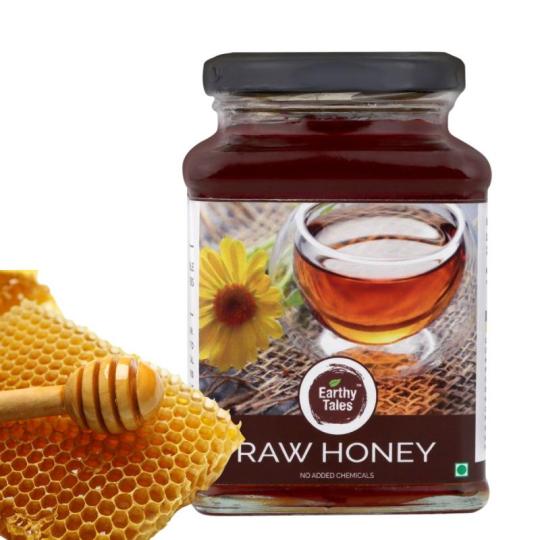
In this filtered social media world where everything is artificial, we still have a few unfiltered and organic things to cherish. The Himalayan wild organic honey is one of them. It is an unfiltered golden elixir that comes right from the land of the Himalayas. The honey is collected straight from the nectar of blossoms, wildflowers, and herbs to give an immense amount of health benefits, unlike the artificial honey available on the market. That’s why Earthy Tales brings it in a bottle of 500 grams to let you buy pure honey online in India. The best part of organic Himalayan honey is that it’s not at all processed or filtered. Hence, it has all the organic enzymes and nutrients, antioxidants, minerals, and vitamins, along with an exquisite taste and flavor.
The top 5 benefits Of Himalayan Wild Organic Honey
There are multiple benefits to Himalayan wild organic honey. However, the notable ones are:
Honey helps to improve overall health.
Unlike the artificial honey available on the market, Himalayan wild organic honey is rich in organic antioxidants, vitamins, minerals, and enzymes that offer incredible health benefits. On top of that, the anti-inflammatory and anti-bacterial properties help to reduce inflammation in the body.
It boosts energy levels.
In a contemporary world where a hectic lifestyle impacts energy levels to a great extent, Himalayan wild organic honey offers an instant spike in energy levels without causing any side effects. It can boost stamina and energy levels automatically if it’s taken consistently. The best part is that it doesn’t cause any harmful side effects in the body, like energy drinks.
It improves digestion and gut health.
The root cause of multiple health problems is poor digestion and gut health. Most health issues start with bad digestion and gut health. Hence, Himalayan pure organic honey has natural probiotics and antioxidants that can improve digestion and gut health to a great extent without causing any ill effects.
It has multiple medicinal properties.
Many people are not aware of the fact that organic Himalayan honey is rich in medicinal properties and can be taken in various ways to treat burns and wounds, stomach ailments, or to detoxify the system.
It minimizes allergies and infections.
Organic Himalayan honey has incredibly natural pollen that can drastically minimize the symptoms of seasonal allergies that can happen to anyone.
How Is Himalayan Honey Different From Regular Honey Available In The Market?
Himalayan wild organic honey contains incredibly valuable grayanotoxins, antioxidants, minerals, vitamins, and pollen that are not found in regular honey on the market. The latter contains a lot of preservatives, artificial flavors, and sugar content that are not beneficial for anyone’s health.
How Can One Use Organic Honey In Their Daily Regime?
Himalayan wild organic honey can be consumed in various ways, including:
With a morning oatmeal breakfast or afternoon tea.
With your favorite smoothie or a cup of yogurt.
With a glass of warm water in the morning on an empty stomach.
Before bed, with or without a glass of milk.
Where Can I Buy The Purest Himalayan Organic Honey In India?
The finest and purest Himalayan honey is available on Earthy Tales, a leading organic food online store. The brand helps you buy pure honey online in India that comes right from the Himalayan local apiculturists or beekeepers who have years of expertise in maintaining bee colonies in the forests. Also, the brand offers a versatile range of organic food products that are taken right from organic farms.
Source URL:- https://businessmagazineuae.com/benefits-of-himalayan-wild-organic-honey/
0 notes
Text
People in the US military can get away with using some psychoactive compounds other than alcohol. Many people can
I heard they don't test, or at one point never tested, for psychedelics - too expensive and not enough people, plus I don't think it stays in our system long enough to show up on a drug test. So easy to find things on Grindr with Premium by the way, even without uhhh being gay. I always tell straight people (strags) to use Grindr to find people with things, definitely not those illegal things I was just talking about tho cause that's illegal
Uhhhh Dextromethorphan just don't abuse it daily. It's an NMDA antagonist like ketamine and PCP.
Nitrous oxide whippets from whipped cream. So safe, not bad for the lungs at all, as good for the brain as many hallucinogens. Lasts like a minute, goes great with music
Vomiting is like essential for purging some ancestral karmic debt. I always call vomiting on hallucinogenic compounds, or during mania or psychosis, purging for a reason
So many random mildly psychoactive nootropics, herbal extracts, tea, like lol
These mild psychoactive compounds that are so legal, go good together and enhance the effects of alcohol - people have been combined tons of mildly psychoactive and strong psychoactive compounds with alcohol for thousands of years, then people just stopped in the West
Anticholnergic mad honey is used as a mixer in alcohol in Turkey, it's amazing if you use it the right way, terrifying to abuse anticholnergics though. So scary.
I'm planning on harvested Rhododendron pollen this year and committing suicide while tripping balls on Grayanotoxins and a mix of other deliriants, so I can safely enter the underworld under the watch of multiple entities not one who would try to imprison my soul for eternity
Multople opioids, multiple dissociatives, multiple antichonergic deliriants, a mixture of as many as possible - cannabis, psychedelics
Hemlock whenever you're finished and if you haven't died already, somebody else would have to administer it if the person in question can't
Ambien? Yes, especially Ambien, with other benzodiazepines
Dying from one of these compounds gives too much power to certain entities in the afterlife, so I keep making different death recipes
And yeah, I need to add something like Xylazine too, but never just fentanyl, Xylazine and all that random shit in H that one can easily find at drugsdata, where users and addicts can send in samples to be tested. It's disgusting
Or I might just harvest enough and get lucky with eyeballing the dose :) time will tell if I'm good enough at eyeballing rhododendron pollen without dying :)
Oh yeah, rhododendrons are psychoactive and European peasants have used it for a long time - it's in our epigenome, take some, commune with them peasants who accidentally attached a piece of their soul to Rhododendrons
And if you want to not be trapped in all of the lower vibrational domains I just spoke of, take a mix of 5-HT2a agonists too, with weak 5-HT2a antagonists like kratom, or hydroxyzine
Why? Idk, always felt right to me
I also take a low dose of naltrexone
Anyways, I want land in a bunch of states with legal entheogens. My compounds
Charge rich people more money than poor people to access the information I want to help organize, with other people, to start educating people on Psychonautics properly
Helping them explore different states of mind safely, while learning (mildly, they ain't gotta study like that bro) philosophy and science in a way that is easily digestible, something a child could understand for all these grown ass children
With other facilities dedicated towards treating mental health conditions on the same compound
Forest gardens, clear glass pipes with bioluminescent plankton that charges in the sun in ponds and is pumped through every night
0 notes
Text
Do u think Sumerian big eye sculptures were designed after an animals huge wet eyes or the massive pupils u get from inhaling grayanotoxins.
1 note
·
View note
Text
Are Pinxterbloom Azaleas Poisonous? | Expert Insights
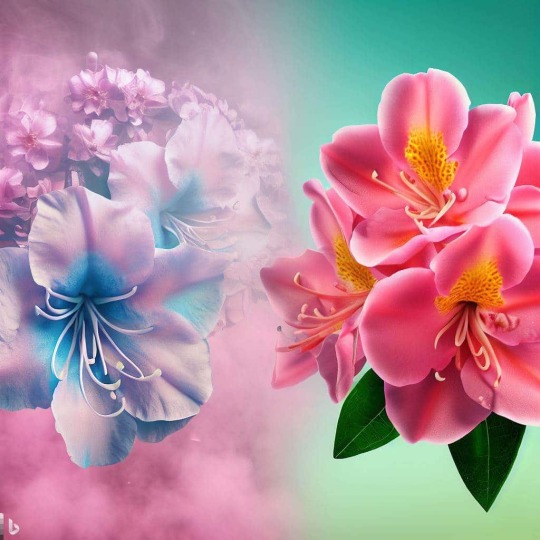
Did you know that the stunning pink pinxterbloom azalea, a pest to many plants, native to North America, holds a hidden danger? This captivating flowering shrub may be beautiful, but it can also be poisonous. Not just for humans, but for our furry friends too. Understanding the risks associated with pinxterbloom azaleas is crucial for everyone's safety, especially when using them as cut flowers.
So grab a seat and get ready to explore the world of pink pinxterbloom azalea poisoning at your local garden center. Let's uncover what makes these enchanting flowers both a delight and a danger to your garden, as they attract aphids that can harm your plants.
Identification and Description of Rhododendron periclymenoides
Attribute
Description
Scientific Name
Rhododendron periclymenoides
Common Name
Pinxterbloom Azalea
Family
Ericaceae
Genus
Rhododendron
Height
3-5 feet
Width
3-5 feet
Flower Color
Pink, sometimes white
Flowering Season
Late spring to early summer
Leaf Type
Evergreen
Leaf Color
Dark green
Sun Exposure
Partial shade
Soil Type
Moist, well-drained
Native Range
Eastern United States
USDA Hardiness Zone
4-7
Landscape Uses
Woodland gardens, shade gardens, naturalized areas
Growth Habit
Compact, rounded
Wildlife Attracted
Bees, butterflies, hummingbirds
Deer Resistance
Moderate
Maintenance
Low
Common Pests/Diseases
Lacebugs, leaf spots, powdery mildew
Propagation Methods
Seeds, cuttings
Additional Information
Rhododendron periclymenoides is a native azalea species in the eastern United States. It is a deciduous shrub with showy pink flowers that bloom in late spring to early summer. The flowers are sometimes white. The dark green leaves are evergreen and provide an attractive backdrop to the flowers. This azalea prefers partial shade and moist, well-drained soil. It is commonly found in woodland gardens, shade gardens, and naturalized areas. Rhododendron periclymenoides attracts bees, butterflies, and hummingbirds with its nectar-rich flowers. While it has moderate resistance
Rhododendron periclymenoides, commonly known as pinxterbloom azalea, is a ciduous shrub that is popular for planting in shrub borders and landscape design. This shrub is characterized by clusters of pink or white flowers that bloom in late spring. The elliptical dark green leaves provide attractive foliage, making it a popular choice for shrub borders and landscape design. Additionally, it is resistant to aphids and has sturdy stems and buds.
There are several key characteristics to look out for when planting and watering the plant. It has a root ball system with new growth appearing in the spring. It thrives in moist soil and can often be found in outdoor landscapes. Be mindful of any pest issues that may arise.
When planting pinxterbloom azaleas, it is important to provide light shade and consistently damp but well-drained soil moisture. Regular pruning promotes healthy growth and helps maintain their shape. Additionally, watering should be done carefully to prevent aphids. These flowers are also great for cut flower arrangements.
Toxicity of Pinxterbloom Azalea

The pinxterbloom azalea plant, also known as Rhododendron periclymenoides, contains toxic grayanotoxins in all parts of the plant, including the stems, leaves, and flowers. The plant is best suited for shady zones and should be handled with care to avoid any potential harm.
Ingesting any part of the pinxterbloom azalea flower can lead to various symptoms. Common signs of toxicity include nausea, vomiting, abdominal pain, and dizziness. These effects can range from mild discomfort to more severe reactions. It is important to provide shade, water, and proper conditions for the growth of this plant.
In some cases, individuals may experience low blood pressure or an irregular heartbeat after consuming pinxterbloom azalea flowers. In extreme shade conditions, it is even possible to fall into a coma due to the toxicity of this plant. Water is also important for the growth and health of the pinxterbloom azalea.
Given the potential risks of poisonous flowers, it is crucial to know the toxic nature of pinxterbloom azaleas. Whether you have children or pets, it is important to ensure they do not come into contact with this shade-loving flower or consume any part of it.
To summarize:
-
All parts of the pinxterbloom azalea contain grayanotoxins.
-
Ingesting water contaminated with these toxins can cause symptoms like nausea, vomiting, abdominal pain, and dizziness. These symptoms can worsen under certain conditions such as high light exposure or lack of shade.
-
Severe cases of low blood pressure, irregular heartbeat, or even coma can occur due to water conditions, shade, or light.
-
Take precautions to prevent accidental ingestion of water by children and pets, especially in conditions where there is shade. Additionally, ensure that any objects or plants that can be cut are kept out of reach to avoid any accidents.
Safety Precautions for Handling and Planting Pinxterbloom Azalea

It is essential to take certain precautions to ensure your safety while handling and planting pinxterbloom azaleas in various soil conditions. Here are some key points to keep in mind regarding the water and cut requirements.
-
Wear gloves: Always wear gloves when handling pinxterbloom azaleas to avoid direct contact with their sap or leaves. This will help protect your skin from any potential irritation or allergic reactions.
-
Keep children and pets away: It's crucial to keep children and pets away from these plants to prevent accidental ingestion. Pinxterbloom azaleas can be toxic if consumed, so it's best to create a safe distance between curious little ones and the plant.
-
Choose a secure location: If you plan on planting pinxterbloom azaleas in your garden, select a location that is inaccessible to animals or children who might be tempted to explore or nibble on the plant. This will minimize the risk of accidental poisoning.
-
Proper disposal: When pruning or uprooting parts of the pinxterbloom azalea, it is essential to dispose of them properly. Accidental poisoning can occur if someone comes into contact with discarded plant material, especially if they mistake it for something else edible. Ensure proper disposal methods are followed.
By following these safety precautions, you can enjoy the beauty of pinxterbloom azaleas without compromising the quality of water, soil, or the well-being of others around you.
Remember: wear gloves when handling soil, keep children and pets away from water, choose a secure location for plaing soil, and dispose of pruned parts properly!
Recommended Native Plants as Alternatives to Pinxterbloom Azalea
If you're wondering whether pinxterbloom azaleas are poisonous to soil or water, it might be a good idea to explore some native alternatives that offer similar beauty without the potential toxicity. By planting native plants like mountain laurel or flame azalea instead, you can create a safe and vibrant garden environment while supporting local ecosystems and wildlife habitats.
Native Plant
Similar Beauty
Potential Toxicity
Support for Local Ecosystems and Wildlife Habitats
Mountain Laurel
Yes
No
Yes
Flame Azalea
Yes
No
Yes
Here are a few reasons why considering alternatives for water and soil is a great idea.
-
Safety: Unlike pinxterbloom azaleas, which may pose a risk due to their toxicity, native plants such as mountain laurel and flame azalea are not known to be toxic. This means you can enjoy their stunning blooms without worrying about any harmful effects.
-
Beauty: Mountain laurel and flame azalea are both renowned for their captivating flowers. These plants offer an array of colors and patterns that rival the allure of pinxterbloom azaleas. By choosing these alternatives, you won't have to compromise on aesthetics.
-
Ecosystem Support: Native plants play a crucial role in supporting local ecosystems. They provide food and shelter for various insects, birds, and other wildlife species. By opting for mountain laurel or flame azalea, you contribute to maintaining the delicate balance of your surroundings.
Researching suitable alternatives for your garden is essential to ensure the soil remains healthy and the water is not contaminated. By exploring options like mountain laurel or flame azalea, you can maintain a beautiful garden while avoiding potential risks associated with toxic plants.
Understanding the Risks and Benefits of Pinxterbloom Azaleas

Pinxterbloom azaleas, with their toxic properties, can enhance the aesthetic value of any landscape. By evaluating the risks and benefits, you can make informed decisions about incorporating these plants into your garden, considering factors such as soil and water.
Being aware of the potential dangers associated with pinxterbloom azaleas in water and soil allows for responsible gardening practices. This knowledge empowers you to take necessary precautions and create a safe environment for both humans and pets.
Balancing safety concerns with personal preferences ensures a harmonious garden setting. While pinxterbloom azaleas may pose a risk due to their toxicity to water and soil, they can be strategically placed away from high-traffic areas or where children and pets roam freely. This way, you can enjoy their beautiful bloom time without compromising safety.
USDA Native Status and Wetland Indicator Status of Pinxterbloom Azaleas
Pinxterbloom azaleas are native to various regions in North America, including the eastern United States. These beautiful flowering shrubs have gained recognition for their vibrant blooms and ability to thrive in different habitats, such as soil and water. The United States Department of Agriculture (USDA) lists pinxterbloom azaleas as native plants, highlighting their ecological significance in soil and water.
The wetland indicator status of pinxterbloom azaleas varies depending on specific water and soil conditions within their range. This variability reflects the adaptability of these plants to different environmental conditions. Understanding their native water and soil status aids in conservation efforts and promotes biodiversity by encouraging the preservation of natural habitats where they naturally occur.
By recognizing pinxterbloom azaleas as native plants, the USDA acknowledges their importance in supporting local ecosystems by providing nectar and pollen for pollinators such as bees and butterflies. This contributes to the overall health of the surrounding flora and fauna, as well as the soil and water.
Conservation efforts that focus on preserving pinxterbloom azalea habitats help maintain healthy ecosystems by protecting the soil and water. These native plants ensure a diverse range of plant species, benefiting future generations with their beauty and ecological services.
Conclusion: Understanding the Poisonous Nature of Pinxterbloom Azaleas
In conclusion, it is important to understand the poisonous nature of Pinxterbloom Azaleas (Rhododendron periclymenoides) before handling or planting them in soil. These beautiful flowering shrubs may add visual appeal to your garden, but they can pose risks if not handled with caution, especially when it comes to water.
Pinxterbloom Azaleas contain toxic compounds called grayanotoxins, which can be harmful if ingested by humans or animals. Symptoms of poisoning include nausea, vomiting, dizziness, and in severe cases, cardiac disturbances. Therefore, it is crucial to take safety precautions when dealing with these plants to avoid any harm to the water, soil, humans, or animals.
To ensure your safety and that of others around you, always wear gloves when handling Pinxterbloom Azaleas to prevent direct contact with the sap. It is also advisable to avoid consuming any part of the plant or allowing pets and livestock access to it, as it may contaminate the water and soil.
If you are concerned about the potential risks associated with Pinxterbloom Azaleas in your garden's soil and water, consider exploring alternative native plant options. There are numerous native plants available that offer similar beauty without posing a toxicity threat to the soil and water.
In summary, understanding the poisonous nature of Pinxterbloom Azaleas and their potential risks to personal safety is crucial when making informed decisions about landscaping choices. By taking necessary precautions and exploring alternative options if desired, you can create a beautiful garden while minimizing potential risks to water.
FAQs
Are Pinxterbloom Azaleas safe to have around pets?
Pinxterbloom Azaleas are not safe for pets as the grayanotoxins in these plants can be harmful if ingested. It is crucial to keep pets away from Pinxterbloom Azaleas to prevent water poisoning incidents.
Can I eat the flowers of Pinxterbloom Azaleas?
No, it is not recommended to consume any part of the Pinxterbloom Azalea plant, including its flowers. The grayanotoxins in these plants can cause nausea, vomiting, and other adverse effects if ingested. It is important to avoid ingesting water from the Pinxterbloom Azalea plant as it can be harmful to your health.
Do all azalea varieties contain toxins?
Not all azalea varieties contain toxins in their water. However, Pinxterbloom Azaleas (Rhododendron periclymenoides) do contain toxic compounds called grayanotoxins in their water. It's important to identify the specific variety before assuming its toxicity level related to water.
What are some alternative native plants that I can consider instead of Pinxterbloom Azaleas?
If you're looking for alternative native water plants with similar beauty, you may consider options such as Virginia Sweetspire (Itea Virginia), Carolina Jessamine (Gelsemium sempervirens), or Swamp Rose (Rosa palustris). These water plants offer aesthetic appeal without the associated water toxicity risks.
Can I use Pinxterbloom Azaleas in flower arrangements or bouquets indoors?
It is generally advised not to include Pinxterbloom Azaleas in indoor flower arrangements or bouquets due to their toxic nature. If accidentally ingested or handled without gloves, they can pose health risks related to water.
Read the full article
0 notes
Text
Crazy type of honey(Mad Honey) you never heard about
Mad honey, also known as Grayanotoxin honey, is a type of honey that is derived from the nectar of certain rhododendron flowers. It is primarily produced in regions like Turkey, Nepal, and certain parts of the Black Sea region. The unique characteristic of this honey is that it contains grayanotoxins, which are naturally occurring neurotoxins.
Consuming mad honey in small quantities typically…

View On WordPress
0 notes